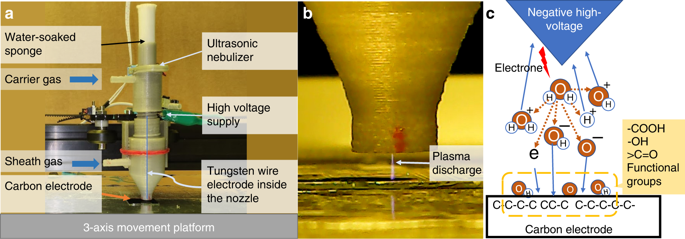Microsystems & Nanoengineering ( IF 7.3 ) Pub Date : 2019-11-18 , DOI: 10.1038/s41378-019-0103-0 Aung Thiha 1, 2 , Fatimah Ibrahim 1, 2 , Shalini Muniandy 2, 3 , Marc J Madou 1, 2, 4, 5

|
Carbon micro- and nanoelectrodes fabricated by carbon microelectromechanical systems (carbon MEMS) are increasingly used in various biosensors and supercapacitor applications. Surface modification of as-produced carbon electrodes with oxygen functional groups is sometimes necessary for biofunctionalization or to improve electrochemical properties. However, conventional surface treatment methods have a limited ability for selective targeting of parts of a surface area for surface modification without using complex photoresist masks. Here, we report microplasma direct writing as a simple, low-cost, and low-power technique for site-selective plasma patterning of carbon MEMS electrodes with oxygen functionalities. In microplasma direct writing, a high-voltage source generates a microplasma discharge between a microelectrode tip and a target surface held at atmospheric pressure. In our setup, water vapor acts as an ionic precursor for the carboxylation and hydroxylation of carbon surface atoms. Plasma direct writing increases the oxygen content of an SU-8-derived pyrolytic carbon surface from ~3 to 27% while reducing the carbon-to-oxygen ratio from 35 to 2.75. Specifically, a microplasma treatment increases the number of carbonyl, carboxylic, and hydroxyl functional groups with the largest increase observed for carboxylic functionalities. Furthermore, water microplasma direct writing improves the hydrophilicity and the electrochemical performance of carbon electrodes with a contact-angle change from ~90° to ~20°, a reduction in the anodic peak to cathodic peak separation from 0.5 V to 0.17 V, and a 5-fold increase in specific capacitance from 8.82 mF∙cm−2 to 46.64 mF∙cm−2. The plasma direct-writing technology provides an efficient and easy-to-implement method for the selective surface functionalization of carbon MEMS electrodes for electrochemical and biosensor applications.
中文翻译:

微等离子体直写用于碳微电极的位点选择性表面功能化
由碳微机电系统(碳MEMS)制造的碳微电极和纳米电极越来越多地用于各种生物传感器和超级电容器应用。有时需要用氧官能团对所生产的碳电极进行表面改性,以实现生物功能化或改善电化学性能。然而,传统的表面处理方法在不使用复杂的光致抗蚀剂掩模的情况下选择性地靶向部分表面区域以进行表面改性的能力有限。在这里,我们将微等离子体直写作为一种简单、低成本和低功耗的技术,用于具有氧功能的碳 MEMS 电极的位点选择性等离子体图案化。在微等离子体直写中,高压源在微电极尖端和保持在大气压下的目标表面之间产生微等离子体放电。在我们的设置中,水蒸气充当碳表面原子羧化和羟基化的离子前体。等离子体直写将 SU-8 衍生的热解碳表面的氧含量从约 3% 增加到 27%,同时将碳氧比从 35 降低到 2.75。具体而言,微等离子体处理增加了羰基、羧基和羟基官能团的数量,其中观察到的羧基官能团的增加最大。此外,水微等离子体直写改善了碳电极的亲水性和电化学性能,接触角从~90°变为~20°,阳极峰与阴极峰的分离从0.5 V减少到0.17 V,并且比电容从 8.82 mF∙cm -2增加到 5 倍至 46.64 mF∙cm -2。等离子体直写技术为电化学和生物传感器应用的碳 MEMS 电极的选择性表面功能化提供了一种高效且易于实施的方法。











































 京公网安备 11010802027423号
京公网安备 11010802027423号